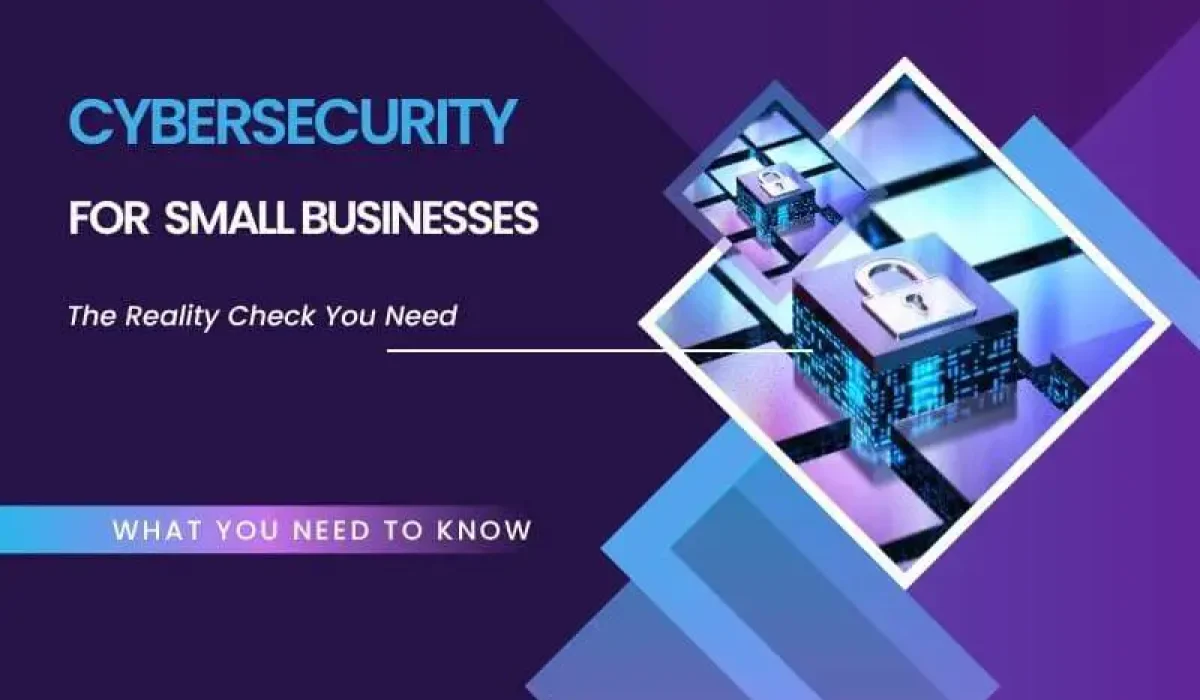Let’s talk straight here. Cybersecurity isn’t just for the big guys anymore.
That comforting myth? Dead and buried. In 2025, every small business owner I know has either been hit by a cyberattack or knows someone who has. The landscape has shifted dramatically, and frankly, it’s terrifying and fascinating at the same time.
Table of Contents
The Uncomfortable Truth About Small Business Targets
Here’s what keeps me up at night thinking about small businesses: hackers have figured out something brilliant. Why spend months trying to crack Fort Knox when you can walk through an unlocked door?
Small businesses are that unlocked door. We’re talking about 43% of cyberattacks targeting small businesses – not because they’re unlucky, but because they’re easy. 46% of all cyber breaches impact businesses with fewer than 1,000 employees. What is the average cost of a data breach globally? A soul-crushing $4.88 million – a 10% increase from the previous year.
But here’s where it gets really personal. Last month, I watched Sarah, who runs a local bakery, lose three weeks of sales data because of a ransomware attack. Three weeks. Gone. Her grandmother’s recipes, customer orders, supplier contacts – everything locked behind a digital wall built by criminals who demanded $15,000 to give her life back.
The New Threat Landscape (It’s Scarier Than You Think)
The cybercriminal playbook has evolved. Dramatically.
AI-powered attacks are now mainstream. We’re seeing phishing emails so sophisticated that even tech-savvy business owners are falling for them. These aren’t the clunky “Nigerian prince” scams anymore – they’re crafted with surgical precision, mimicking your bank, your suppliers, even your own employees. Around 43% of all recorded phishing attacks were imitating Microsoft.
Ransomware-as-a-Service has democratized cybercrime. Anyone with basic computer skills can now launch devastating attacks. The barrier to entry? Practically nonexistent.
Supply chain attacks hit where it hurts most. Third-party involvement in breaches has doubled to 30%, according to Verizon’s 2025 Data Breach Investigations Report. One compromised vendor can take down hundreds of small businesses simultaneously.
The Human Factor (Your Biggest Vulnerability AND Your Greatest Strength)
Let me share something that might sting a bit: your employees are both your weakest link and your strongest defense.
Human error factors into 68% of breaches, according to Verizon’s latest research. Social engineering attacks have become devastatingly effective. I’ve seen businesses lose everything because someone clicked on what looked like a legitimate Microsoft security update. The attack? A carefully orchestrated manipulation that played on basic human psychology – urgency, authority, and fear.
But here’s the beautiful part – when you invest in your people, they become cybersecurity warriors. Maria, who owns a small marketing agency, turned her entire team into a human firewall. How? By making cybersecurity personal, relevant, and dare I say it… fun.
Building Your 2025 Cybersecurity Fortress (Without Breaking the Bank)
Start with the fundamentals. Seriously.
Multi-factor authentication isn’t optional anymore
It’s survival. Every single account, every single user, every single time. Yes, it’s slightly annoying. You know what’s more annoying? Explaining to your customers why their personal data is now for sale on the dark web.
Password management is your new religion.
If you’re still using “password123” or your dog’s name, we need to have a serious conversation. Password managers like Bitwarden or 1Password aren’t just nice-to-have tools anymore – they’re essential business infrastructure. They generate fortress-strength passwords and remember them so you don’t have to.
Backup like your business depends on it (because it does).
The 3-2-1 rule: three copies of your data, on two different media types, with one stored offsite. Cloud backup services have become incredibly affordable – we’re talking $10-50 per month for most small businesses. Compare that to the cost of losing everything.
Network security that actually works.
Your Wi-Fi password shouldn’t be your business name followed by “2025.” Invest in a business-grade firewall. Update your router firmware regularly. Create a separate guest network. These aren’t luxury features – they’re basic hygiene in 2025.
The Software Shield: Choosing Protection That Fits
Endpoint protection has evolved beyond traditional antivirus. Companies like CrowdStrike, SentinelOne, and Microsoft Defender for Business offer AI-powered threat detection that learns and adapts. The cost? Usually, less than what you spend on coffee each month per employee.
Email security deserves special attention. Microsoft 365 and Google Workspace have built-in protections, but they’re not enough. Advanced email security solutions like Proofpoint or Mimecast catch the sophisticated attacks that slip through.
Vulnerability management sounds fancy, but it’s actually simple: keep everything updated. Exploitation of vulnerabilities has surged by 34% according to the latest Verizon report. Operating systems, software applications, browser plugins – everything. Enable automatic updates wherever possible. Schedule monthly “patch parties” to handle the rest.
Creating a Cybersecurity Culture (The Secret Sauce)
Here’s what the experts won’t tell you: technology alone won’t save you. Culture will.
Make cybersecurity everyone’s job. Not just IT (if you even have an IT department), but every single person who touches a computer, phone, or tablet in your business. From the receptionist to the CEO – everyone needs skin in the game.
Training that doesn’t suck. Skip the boring PowerPoint presentations. Use interactive platforms like KnowBe4 or Proofpoint Security Awareness Training. Make it engaging, relevant, and regular. Monthly five-minute security tips beat annual hour-long seminars every time.
Incident response planning. When (not if) something goes wrong, everyone should know exactly what to do. Who to call, which systems to disconnect, and how to communicate with customers. Practice it. Drill it. Make it second nature.
The Compliance Reality Check
Data protection regulations aren’t going away – they’re multiplying. GDPR, CCPA, HIPAA, PCI DSS – the alphabet soup of compliance requirements can feel overwhelming. But here’s the thing: good cybersecurity practices usually satisfy multiple compliance requirements simultaneously.
Cyber insurance has become non-negotiable. But – and this is crucial – insurance companies are getting pickier about who they’ll cover. You’ll need to demonstrate basic cybersecurity hygiene before they’ll even consider your application.
Emerging Threats on the Horizon
Quantum computing might sound like science fiction, but it’s not. When quantum computers become mainstream (we’re talking 5-10 years), they’ll crack current encryption methods like opening a tin can. Forward-thinking businesses are already planning for quantum-resistant security.
IoT device proliferation creates new attack surfaces daily. Smart thermostats, security cameras, and even coffee machines can become entry points for attackers. Every connected device is a potential vulnerability.
Deepfake technology is making social engineering attacks more sophisticated than ever. Voice cloning, video manipulation – the tools that once required Hollywood budgets are now available to anyone with a laptop.
The Investment Mindset Shift
Stop thinking about cybersecurity as an expense. Start thinking about it as insurance for your business’s future.
The numbers are stark: 60% of small businesses that experience a cyber attack go out of business within 6 months. Not because they can’t afford the ransom or the technical recovery, but because their customers lose trust and take their business elsewhere.
Your cybersecurity investment should be proportional to what you have to lose. If your business relies on customer data, intellectual property, or digital operations (spoiler alert: every business does in 2025), then cybersecurity isn’t optional – it’s foundational.
Building Your Action Plan
Week 1:
Enable multi-factor authentication on all critical accounts. Install a password manager. Update all software and operating systems.
Week 2:
Implement automated backup solutions. Review and strengthen your Wi-Fi security. Conduct a basic security audit of your most critical systems.
Week 3:
Begin employee security awareness training. Create an incident response plan. Research cyber insurance options.
Month 2 and beyond:
Regular security assessments, ongoing training, and continuous improvement of your cybersecurity posture.
The Human Side of Digital Protection
At the end of the day, cybersecurity isn’t about technology – it’s about people. It’s about protecting the dreams you’ve built, the customers who trust you, and the employees who depend on you.
Sarah’s bakery? She rebuilt stronger than before. Not just her digital systems, but her entire approach to business resilience. She learned that cybersecurity isn’t just about preventing attacks – it’s about building a business that can weather any storm.
Your small business matters. Your customers’ trust matters. Your employees’ livelihoods matter. In 2025, protecting all of that starts with taking cybersecurity seriously.
The threats are real. The solutions are available. The choice is yours.
But remember – in the world of cybersecurity, you’re not just protecting data and systems. You’re protecting dreams, relationships, and futures. That’s worth investing in, don’t you think?
Key Statistics Summary (2025 Updates)
- 43% of cyberattacks target small businesses
- 46% of all cyber breaches impact businesses with fewer than 1,000 employees
- Average cost of a data breach: $4.88 million (10% increase from the previous year)
- 60% of small businesses go out of business within 6 months after a cyberattack
- 68% of breaches involve human error
- Third-party involvement in breaches has doubled to 30%
- Exploitation of vulnerabilities has surged by 34%
Sources: IBM Cost of Data Breach Report 2024, Verizon 2025 Data Breach Investigations Report, and various cybersecurity research firms
You May Also like this article: The Role of AI in Cyber Security: A Comprehensive Guide




